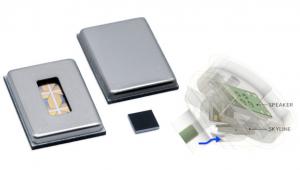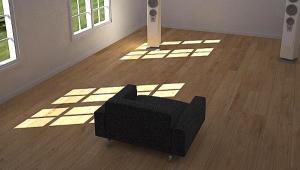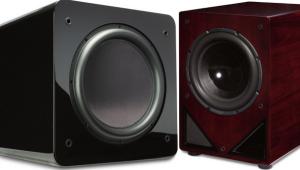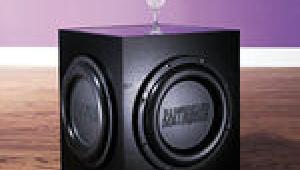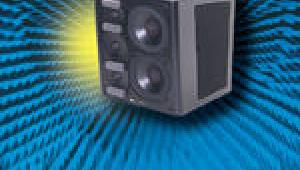Andrew Welker, R&D Manager, Axiom Audio
 Andrew Welker is a mainstay of the Canadian speaker engineering community, now heading up most of the design work for Axiom audio after a dozen years working on the Mirage and Energy brands at Audio Products International (since purchased by Klipsch and VOXX International).Excerpts from this interview appear in the feature story “Subwoofers: The Guts and the Glory.”
Andrew Welker is a mainstay of the Canadian speaker engineering community, now heading up most of the design work for Axiom audio after a dozen years working on the Mirage and Energy brands at Audio Products International (since purchased by Klipsch and VOXX International).Excerpts from this interview appear in the feature story “Subwoofers: The Guts and the Glory.”
S&V: What’s the most important aspect of a subwoofer: the driver, the enclosure, or the amplifier?
AW: I don’t think there’s any one thing that makes a good subwoofer. A major determiner is that the design is balanced, so everything’s made to work together. To say the driver is most important, well, I can make a woofer that handles 1,000 watts all day long, but if I stick it in a cabinet that doesn’t load it properly, there’s no point in having that glorious woofer in the system. In the world of consumer products, we rarely have the luxury of “sky’s the limit,” no-budget designs. We’re designing to meet a certain balance of criteria, such as the target price. It’s, “How can I balance the things I have to work within that budget?”
There are photos of all these massive drivers online, and everyone tends to want that. But those drivers probably wouldn’t work in most subwoofer designs. You can make a good subwoofer in a reasonably sized cabinet with a modest sized amplifier if you design the right driver for it. It has become easier as the materials science has improved. There have also been a lot of important improvements in adhesives, which is something that doesn’t get talked about.
S&V: How do you feel about the high-efficiency subwoofer amplifier technologies out there, such as Class D, Class G, and Class H? Do you feel a traditional Class AB amp offers better sound? Or do you feel Class AB is still viable?
AW: There’s nothing wrong with any of them, particularly when it comes to subs. The sweet spot is in high-efficiency topologies like D or H. because of the environment we’re asking those amplifiers to work in. Dealing with a high-powered Class AB amp inside a subwoofer enclosure is difficult. You need massive heat sinks to do that.
There’s also a lot of concern about power consumption these days. Class D allows us to get a lot of amplifier power in a small package. They don’t generate a lot of heat. Standby power can be easily a tenth of that of a similarly powered Class AB amp. So all the amps we use are Class D.
S&V: Do you have concerns about the sound quality of Class D amps?
AW: I don’t. We’ve been making standalone Class D amplifiers, full-range amps, for years. The technology is mature enough, the output devices have gotten a lot better, and I think they’re every bit the equal of a good Class AB amp, even when used full-range.
There is this wont to take a switching amp and strap a switching power supply onto it. We’ve found as soon as you replace the switching supply with a conventional linear supply [using a transformer and storage capacitors], you get quite a leap in sound quality. Our subs use a linear supply with big transformers. An amplifier is essentially a modulator of the power supply, so the power supply is actually even more important than the output stage topology.
Also, when you use a switching power supply it’s almost always switching at a different frequency than the amp. Thus, it has its own noise frequency and they can interfere with each other. We can measure how this gets into the analog output of the amp. Linear supplies are faster because of all the power stored up in the capacitors. Then there’s headroom. With a switching supply, if it’s rated for a certain power that’s all you’re going to get. A linear supply can deliver peak current well beyond its rated power, and that current’s available instantaneously. It’s also proven that linear supplies last. You can find amps from the 1950s where the transformers are still working, even if the capacitors have dried out. Many switching supplies seem to be running at the edge, which is why a lot of manufacturers warranty the driver for five years and only warranty the amp for one year.
S&V: Do you have a preference for ported, sealed, or passive radiator subwoofers? How do the design decisions differ among those three?
AW: Some of it depends on the application. If you’re building something that’s going into cabinetry, it’d be silly to put in rear ports. But with a less expensive sub, we don’t have the budget to put in the 1,000-watt amp you might need to get good extension from a sealed enclosure. To get good output with a smaller amp, ported is usually the way to go. It’s a good trade-off. When we get into higher-end models, there’s a threshold you cross. Once you get into large drive units with a big amp, port noise can rear its head very quickly. For our top model, which has two 12-inch drivers, there’s no way you can port that box without getting some chuffing, which is why we went to a sealed enclosure.
"To get good output with a smaller amp, ported is usually the way to go. It’s a good trade-off."
We’re not beholden to this idea of group delay, which seems to be a pet measurement of some of the subwoofer people. There’s no good data showing perceivable levels of group delay at various frequencies. All the papers that have been written only deal with group delay at mid and high frequencies. We’ve simulated different group delays with DSP [digital signal processing], and in controlled blind testing we haven’t found any audible difference when we added more group delay to the sub’s natural group delay.
S&V: Can a minisub—and by that I mean a small sub that gets deep extension and high output by using high-excursion drivers and high-powered amps—equal the performance of a conventional, larger sub?
AW: They can work. A lot of them don’t work, in my experience. I would say where form factor is of greatest importance and maximum SPL at low frequencies isn’t, they’re a perfectly suitable alternative to a larger, more conventional design. I’ve worked on minisub designs in the past when I was with the API group, and they always sound a little bit strained. I don’t think there’s any measurement I can put my finger on to say what’s going on, but I’ve never heard one that has effortless reproduction of low frequencies, below say 40 Hz. They can do upper bass reasonably well, but in the low bass, they just sound strained.
From a technical standpoint, you’re essentially trying to break laws of physics. You take a driver and squeeze it into very small box. There’s no way you can put in a port because of the noise. Nor would have you the room. You have to go sealed or passive radiator. In my experience, you have to try and get good quality bass and get as low an extension and sensitivity with the driver and cabinet you have. The natural alignment of a woofer in such a small box is going to be –13, –18, or maybe –20 dB down at 40 Hz. The only way to overcome that is to throw a pile of amplifier power at it. At 100 Hz, you’re putting in 50 watts. To get the same output at 20 or 30 Hz, you may need 10 times that. So when you’ve got the power, you have to overbuild the driver to take that abuse. You need a longer voice coil, which demands more motor strength, which means more magnet, and more space, and you just made the natural alignment even worse. And I think that because everything’s fighting, you don’t get the effortless quality you get from a good conventional sub.
S&V: What kinds of measurements do you do to evaluate a subwoofer design?
AW: We’re very big on having a true anechoic response, mainly because there’s no guesswork involved. We have a 90-foot tower so we can do true free-space measurements. We used that to create a correction curve for our anechoic chamber. There’s an absolute consistency in that measurement. I can take a sub we made two years ago, do a measurement today, and it’ll be the same. With ground plane [measuring a subwoofer with the sub and mic on an open, flat space such as a parking lot], even if you have a target spot in your parking lot, if one or two cars are moved it can change the measurement.
We also measure distortion, in a number of different ways. We look at the distortion spectrum using tone bursts, sine chirps, steady-state sine, and multi-tone analysis, like 60 and 80 Hz at same time. We do that at low levels where driver and amp aren’t stressed, and also running the sub full-out. One of the biggest sources of distortion are non-harmonic noises, such as when you drive subs into a limiter. Any well-designed sub has to have a limiter, but limiters can have nasty behavior the harder you drive them, so you create noises that have no relation to program material. This is easier to hear than high levels of second-order distortion. Some of the noises are bad enough that they create a growling sound, so you convert a clean sine tone to a growl. A lot of them will pump as well, making the volume go up and down. If the attack and decay rates of the limiter aren’t properly set, you can get to the onset of distortion and hear the level changing.
One thing I’d like to see discussed in reviews is, what happens when you overdrive the sub? A lot of subs will make some interesting and strange noises.
There’s also CEA-2010. It’s a nice idea, trying to distill down to data that might be useful for comparing two products, and consumers like to see everything reduced down to a number. But frankly, the standard is so fraught with open-ended things like what software, what mic, what distance. It’s problematic. With ground plane [the measurement technique used in CEA-2010], errors are largest at low frequencies. When you start getting into the variability with different people doing the measurements, it’s easy to see where you might have two very good subs from two manufacturers, and one is judged better because it’s performing 2 dB better at low frequencies than the other. I guarantee you that you could see ±2 dB variability in those measurements if they’re done by different people with different gear in different environments.
The idea is an excellent one. There’s no way I’d argue anything with Don Keele [the engineer and former reviewer for the now-defunct Audio magazine who did much of the work behind CEA-2010]. If I could guarantee that those measurements are repeatable within half a dB or 1 dB, I could approve of it. But I can easily get 1 or 2 dB variation just moving around our parking lot. Also, CEA-2010 doesn’t tell you anything about how a subwoofer is going to sound. And it doesn’t take into account room modes, which can be activated differently by different alignments.
There’s the suspicion that if manufacturers don’t want to adhere to CEA-2010, it’s because they’re scared their subwoofers won’t perform well on the test, but that’s not necessarily the case. I would much rather the buying public look at the rep of the company. Go online and see what people think. And either go to a dealer and hear it, or if it’s an Internet-direct company try it and send it back if you don’t like it.
S&V: What goals do you set when you tune the digital signal processors on your subwoofers? Do you make the response flat, or do you put bumps in the response to give the sub a certain sound?
AW: It’s nice that DSPs are coming down enough in price that you can get them into very inexpensive models. We use traditional analog EQ in entry-level models, DSP in upper-level models. We found that the biggest difference is in limiter/compressors; you can implement them far more precisely in digital domain. We EQ subs to be flat anechoically, 4-pi flat, which was decided upon based on years and years of blind listening tests.
"We’ve found that when you EQ a sub to be flat, room gain gives you lift in the low frequencies."
But in listening tests we tend to like a lift at the bottom end. If you take an anechoically flat speaker with a nice down-tilted power response, you’re going to get some bass boost when that speaker is placed in a room. We’ve found that when you EQ a sub to be flat, room gain gives you lift in the low frequencies. And that’s what we find to be pleasing. If you put an artificial hump in the bottom end, in most cases you’ll find that to be overbearing.
S&V:Do you have a certain Q [resonance bandwidth] that you prefer?
AW: It’s tough to answer, because when you add EQ that number really doesn’t apply anymore. You can talk about passive system Q, the drive unit it its box. You can make the Q maximally flat, like 0.707, because that gives you the most efficient alignment. But unless you’re talking refrigerator-sized subs, you’re not going to get natural response down to 20 Hz. And as soon as you add EQ, the Q goes out the window. We tend to use a steep high-pass filter just below the cut-off frequency, to reduce possibility of extraneous noises from sub-harmonic content. If you try to reproduce notes that low, all it does is eat up amplifier power, push the driver past its excursion limits, and add noises that don’t contribute to the experience.
S&V: Would you recommend S&V readers buy four smaller subs, two midsized subs or one large sub, if the price for the different packages were about the same?
AW: I think the sweet spot is to buy two. That’s going to give you a pretty decent balance between output level and linearity. If all you’re concerned about is output and you think your room correction system can fix the problems—although it can’t—go for the single $1,500 sub. If it’s a smaller room or you don’t listen that loud, absolutely put in four subs. We did a study on this a few years ago and four subs will always give you the smoothest response. With two you get fairly decent output but it’ll be smoother than just one.
People think when you put more subs in you get +3 or +6 dB more output. That might happen if you stacked them in a corner. But if they’re in different positions, where there might be a peak with one sub’s output it might be a dip with another sub, and they’ll cancel each other out. You may get a little more output and you’ll certainly get more headroom. But two subs doesn’t mean +6 dB more output compared to one.
S&V: How do you feel about the automatic EQ and room correction technologies that are built into receivers and pre/pros?
AW: As long as you can force them to work only at low frequencies, they can be very beneficial. Broadband room correction we are in total disagreement with because there’s so much variability, not only in the way the different systems work but in the target curves they’re attempting to correct to.
A properly designed loudspeaker will work in any decent room. If you have a bad room, room EQ may help a little bit, but it’s not going to fix it. Also, the EQ curve shouldn’t have a boost anywhere. You cannot fill in a valley caused by a room mode. You’re just going to waste amplifier power. Either use multiple subs or acoustic treatment to fix the problem. You might get a couple of dB measured improvement by trying to fill in the dip with EQ, but you’ll probably have to boost +6 dB or more, which means you’ll be hitting the limiter earlier, which will affect the sound.
S&V: Any recommendations on how to incorporate a subwoofer into a two-channel system, since almost no two-channel preamps or integrated amps have subwoofer crossovers built in?
AW: The best way to do that with the least likelihood of messing anything up is to run a pigtail from the main speakers to the high-level [speaker cable] inputs on the subwoofer. Or just run them direct from the amplifier’s output terminals. Then you don’t have to worry about shielding or potential noise by running a line-level connection. Some power amps use an inverting topology, so it flips the phase on the main speakers and you can have phase anomalies when you try to blend them with the subwoofer. Yes, you can adjust that on the sub or by changing the sub’s position, but with a non-audiophile customer, that’s way over their heads.
A lot of people will ask, “Shouldn’t I put a high-pass filter on the main speakers?” I don’t think that’s beneficial in systems I’ve experimented with. If you’re adding a sub to tower speakers, the assumption is that you’re already happy with the sound of the tower speaker at low frequencies. Having some overlap with the speakers’ natural roll-off tends to get you a better blend than even if you put matching high-pass filters on mains.
S&V: Any recommendations on placement and setup?
AW: The easiest starting point is to just run the sub alone, with the main speakers off. Play music with some good bass content. Walk around the room and see what’s happening. If you can move the sub, do it, and walk around the room again. Particularly in the seating area, one position may be a little better. Move the sub again and do the same test.
If you’re using bass management in the receiver, just set the sub amplifier’s crossover to the highest frequency. For setting the phase control, assuming you’re not using room correction, it’s always best to listen in stereo and listen to bass guitar or even fairly deep male vocals, and listen with the phase knob or switch in different positions. Nine times out of 10 the setting where it sounds fullest is best.
With any sub, I start with the level in the middle setting. If you’re using a receiver or pre/pro, fine level adjustments are much easier to do through the receiver menus than on the sub itself.
- Log in or register to post comments
